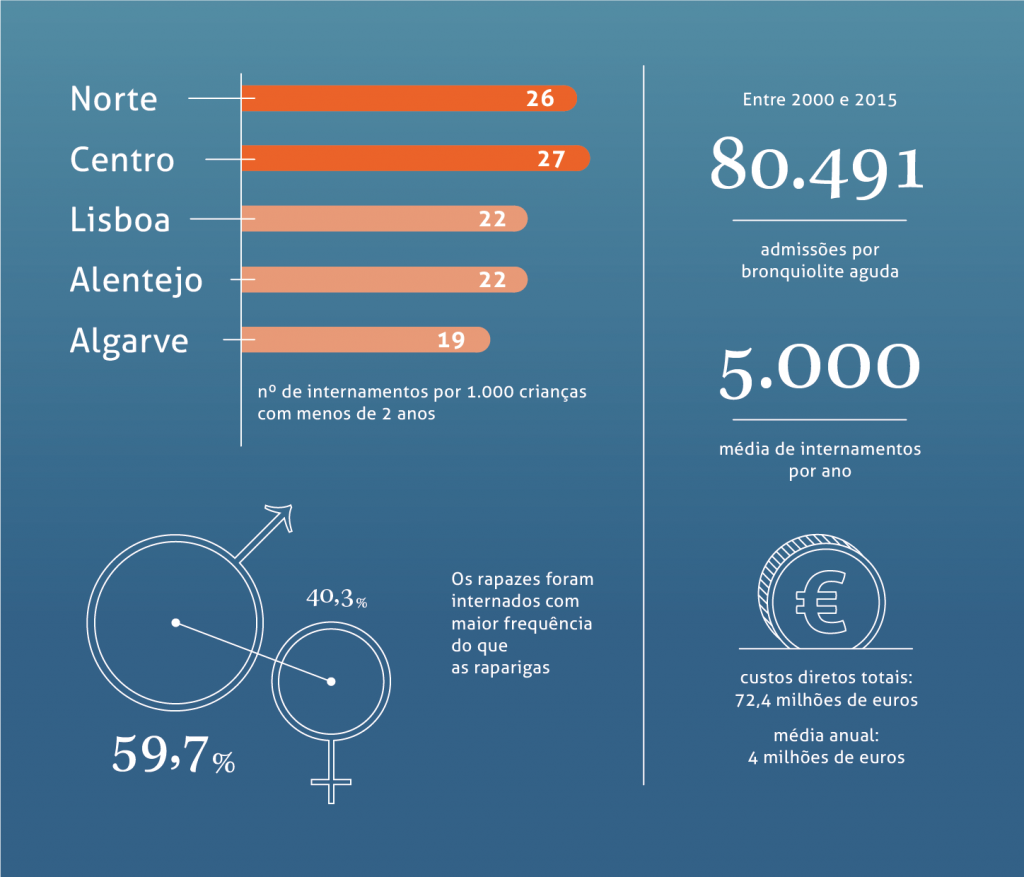In Portugal, the hospitalization rate of children due to acute bronchiolitis is growing, with the highest rates of hospitalization in the North and Center of the country – 26 and 27 hospitalizations per 1,000 children less than two years of age – respectively. These are the conclusions from a work developed by researchers of CINTESIS – Center for Health Technology and Services Research, recently published in the journal Pulmonology.
The researchers analyzed the hospitalization records for children under two years of age. The information was collected from all public hospitals in mainland Portugal between 2000 and 2015. The data, which were anonymized, were provided by the Central Administration of the Health System (ACSS), under a collaboration protocol with CINTESIS.
The results show that about 20% of the hospital admissions of children under two years of age are due to acute bronchiolitis, “an outcome that shows the importance of this disease in the pediatric population,” explains CINTESIS physician and researcher Manuel Gonçalves-Pinho.
In addition to socioeconomic status, temperature variations may explain the discrepancy between rates of hospitalization for acute bronchiolitis recorded at different latitudes. “It is the northernmost regions that have a higher percentage of cases. This may be associated with climatic issues, which dictate that these regions experience more severe winters, with more abrupt drops in temperature,” says Alexandre Silva, author of this paper. The rates recorded in the south are much lower (22/1,000 in Lisbon and Alentejo, and 19/1,000 in the Algarve).
“The study also showed a growing trend of hospitalizations caused by this disease. This trend is most pronounced in younger children, especially in infants less than 3 months of age, growing 3.8% per year, against a rate of 1.6% growth in children up to two years,” say the researchers, who are also professors at the Faculty of Medicine of the University of Porto (FMUP).
In total, 80,491 admissions for acute bronchiolitis were recorded in the study years, averaging 5,000 hospitalizations per year. The boys were hospitalized more frequently than the girls (59.7% vs. 40.3%).
Respiratory syncytial virus, a pathogen known to the medical community as a major cause of respiratory disease in children, has been identified as the cause of 40% of the acute bronchiolitis cases analyzed. However, researchers assume that this percentage may be higher, since not all children are tested for the virus that is the source of their disease.
The research team has in recent years seen an improvement in the way bronchiolitis is treated. “We observed a decrease in the number of X-rays performed, the antibiotics prescribed and injections of corticosteroids administered, according to the national recommendations implemented by the Directorate-General for Health,” the researchers explain. However, there is still an excessive prescription of diagnostic tests and treatments considered ineffective, so we must seek to implement more efficient Health Policies that promote the improvement of care and reduction of expenses.
The total direct costs related to this pathology amounted to 72.4 million euros, on an annual average of 4 million. Each hospitalization cost, on average, 900 euros.
The initial symptoms of bronchiolitis are discharge and nasal obstruction and dry cough, progressively worsening. Breathing can become noisy and wheezing (a sound similar to a kitten meowing) and some babies develop respiratory effort. “Parents should be alert to signs of aggravation, such as faster breathing, panting and signs of exertion (head swelling, groaning, dimples in the neck, marked ribs) and the appearance of respiratory pauses,” says pediatrician Inês Azevedo. The baby may also have some difficulty in eating and drinking fluids, she adds.
In addition to Manuel Gonçalves-Pinho, Alexandre Silva and Inês Azevedo, also Alberto Freitas, principal investigator of the research group 2D4H of CINTESIS and Data Analysis specialist, is author of this paper.

